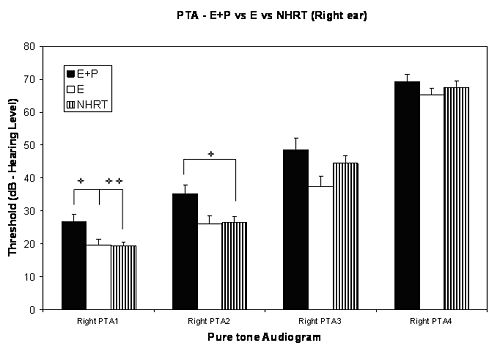
Discovery, Prevention, Therapeutics. One of the Global Center's main R&D strategies is to combine the knowledge and practices of multiple scientific and clinical research disciplines to attack the highly prevalent, complex communication and biomedical problems of hearing impairment, deafness, age-related hearing loss, communication systems, speech perception, and voice quality. These multiple disciplines include audiology, bioengineering, biochemistry, biomedical imaging, cellular and molecular biology, electrical engineering, electrophysiology, gene therapy, genetics, microsystems engineering, neurophysiology, neuroanatomy, psychoacoustics, signal processing, speech science, and voice science.
Representative Projects
Hormones and Hearing
Global Center researchers in the Frisina Lab utilize mouse models to better understand hormonal influences on hearing (Canlon and Frisina, 2009). Price et al. (2009) took a group of middle age female mice and gave them either combination (estrogen + progestin) hormone replacement therapy (HRT), estrogen monotherapy, or placebo, using subcutaneous time-release pellets. They found that across the mouse range of hearing, peripheral (inner ear) measures of hearing declined for the combination HRT subject group relative to the control and estrogen groups, including measures of distortion-product otoacoustic emission levels, and auditory brainstem response (ABR) thresholds. In many regards, these findings are similar to results from our human clinical studies of women who had taken HRT (Guimaraes et al., 2006), underscoring the usefulness of mouse models to study the effects of sex hormones on the auditory system. Current investigations in the Global Center explore the neural underpinnings and molecular mechanisms about how hormones can affect hearing, either positively or negatively.

Figure 1 Legend: Comparisons between hearing abilities of women who had taken estrogen/progestin combination HRT (E+P), women who had taken just estrogen (E), and women of the same age who had never taken HRT (NHRT), for hearing thresholds in the right ear. The E+P group presented with elevated thresholds relative to the E and the NHRT groups at all sound test frequencies, with statistically significant differences for both ears for PTA1 and PTA2. PTA1 represents the average of thresholds for sound frequencies 0.5, 1, and 2 kHz; PTA2 for 1, 2, and 4 kHz; PTA3 for 4, 8, and 9 kHz; and PTA4 for 10, 11.2, 12.5, and 14 kHz. PTA: pure-tone average. * P< 0.05, **P<0.01. (From Guimaraes et al., 2006; Fig. 1).

Figure 2 Legend: Comparisons of ABR threshold changes for middle age female mice at 4 months of treatment with HRT revealed a general trend toward increasing threshold changes with increasing frequency, with the largest trend seen in the E+P treatment group (green). A two-way ANOVA for HRT treatment at 4 months revealed significant differences in ABR thresholds when comparing E+P vs. Placebo (NHRT) at 32 and 48 kHz, and for Placebo vs. Male at 48 kHz. (From Price et al., 2009)
References:
Canlon, B. & Frisina, R.D. (2009) Sex Hormones and Hearing: A Pioneering Area of Enquiry,
Co-Editors, Special Issue of Hearing Research on Sex Hormones and Hearing, Vol. 252: 1-2. (PMCID: PMC2758054) Download PDF
Guimaraes, P., Frisina, S.T., Mapes, F., Tadros, S.F., Frisina, D.R., Frisina, R.D. (2006) Progestin Negatively Affects Hearing in Aged Women. Proc. National Academy Sciences - PNAS. 103: 14246-9. Download PDF
Price, K., Zhu, X., Guimaraes, P., Vasilyeva, O.N., Frisina, R.D. (2009) Hormone replacement therapy diminishes hearing in perimenopausal mice. Hearing Res. 252: 29-36. (PMCID: PMC2698030) Download PDF


